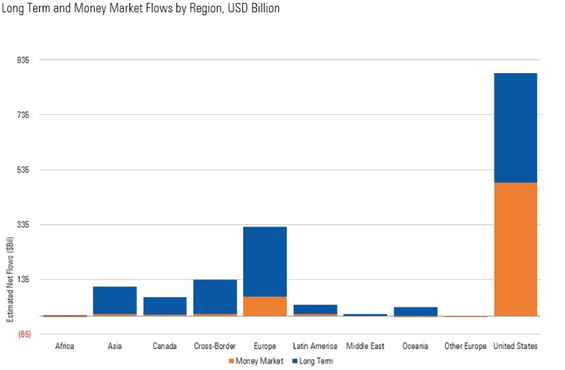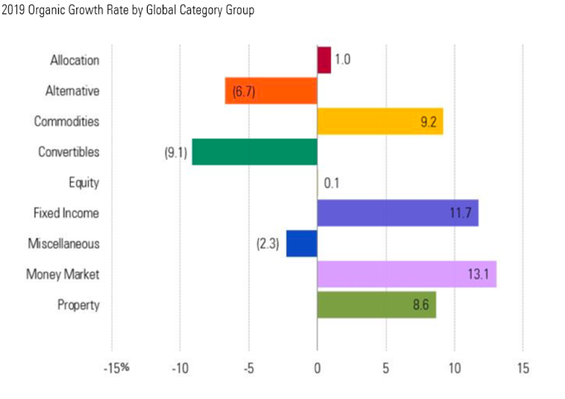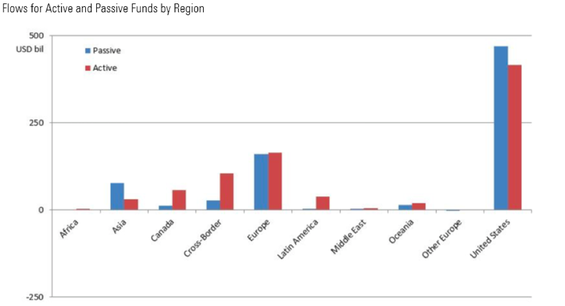Long-term global flows nearly doubled in 2019 to $1 trillion. Money market funds also saw robust inflows of nearly $600 billion, the group’s greatest haul since 2008. On a net basis, nearly all this $1 trillion in long-term flows went into fixed-income funds, which received record inflows and easily surpassed the prior record of $869 billion set in 2017. This wave of demand occurred despite low interest rates globally—and even negative interest rates in some European markets.
In our annual global fund flows report, we dig into these trends and what they demonstrate about investor behavior. Here are a few of our key learnings.
Global flows show Asia and Europe punching above their weight
Total flows—including both money market and long-term funds—added up to $1.6 trillion in 2019, as shown on the chart below.

The United States accounted for 55% of global flows. This was slightly below its market share as defined by total assets, which ended the year at 57%, or nearly $24 trillion.
By contrast, Asia and Europe each punched a bit above their weight.
- Asia’s total flows dropped year over year from $154 billion in 2018 to $108 billion in 2019, but that still accounted for 6.7% of total flows. This sum is above the region’s 4.6% market share as measured by mutual fund and exchange-traded fund assets.
- Europe’s $326 billion in inflows, which was more than double 2018’s total, accounted for 20.2% of global 2019 inflows. This was above the region’s 18.7% market share by total assets.
Large share of U.S. flows go to money market funds
U.S. inflows accounted for an even smaller percentage of long-term (excluding money market funds) flows in 2019, at just 39.1% of global long-term flows. This means that the rest of the world sent $621 billion to long-term funds, or 60.9% of the total.
At the same time, as shown on the chart below, the U.S. collected about $488 billion in money market flows. This was a whopping 82.6% of money market inflows, despite the country having just 64.3% of total money market assets. It isn’t clear why U.S. investors preferred money market funds to a much greater extent than their overseas counterparts, so we plan to assess whether this pattern repeats in 2020. 
Money market funds come out on top for organic growth
When evaluated through the lens of 2019 organic growth by global category group, here’s how the year’s leaders take shape:
- Money market funds saw 13.1% organic growth in 2019—the strongest one-year growth of any global category group. (Morningstar defines organic growth as flows over a specific period divided by beginning assets.) This growth was driven almost entirely by U.S. demand.
- Fixed-income funds came in second with 11.7% growth on an organic basis. Fixed-income funds dominated long-term global flows in 2019, accounting for almost all flows on a net basis and collecting $1 trillion. This interest in both money market and fixed-income funds suggests global investors may be trying to incrementally cut risk, despite low yields.
- Commodities and property funds followed with organic growth rates of 9.2% and 8.6%, respectively, although neither category collected much in absolute terms. They each collected $16 billion in new flows, which was a record for property funds. Investor demand for such funds may reflect their interest in finding inflation hedges in a low-rate environment.
These trends are shown on the chart below. 
The U.S. leads global flows into passive funds
Flows into passive funds break down by region as follows:
- The U.S. led all regions with $470 billion in passive/index fund flows. But, notably, it had the lowest organic growth in passive/index flows of the major regions at 7.2%. In the U.S., passive vehicles account for 35.3% of total assets.
- Europe followed with $161 billion in passive/index flows, which represented organic growth of 12.5%. However, only 21.6% of European assets are in passive/index funds.
- Asia came in third with $77 billion in passive/flows and impressive organic growth of 14.9%. Across all fund categories, 35.5% of Asian assets are in passive/index vehicles, slightly greater than in the U.S.
This distribution is shown on the chart below. 
Global flows into active and passive funds by category
The funds hit hardest by the surge in passive/index demand are equity funds, as active equity lost $357 billion to outflows in 2019. Tellingly, passive/index equity funds collected a similar amount of $366 billion. This suggests a shift from active to index equity exposure. But it also shows the weak net demand for equity funds, which collected just $9 billion overall in 2019. These trends are shown on the chart below. 
Fixed-income funds are one area where active funds still reign: They collected $625 billion, just shy of 2012’s record $635 billion. But passive/index fixed-income flows surged in 2019 as well, taking in a record $383 billion. This was more than $100 billion greater than 2017’s $278 billion.

